Q&A with Simon Rawlings, David Collins Studio
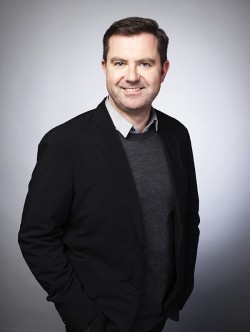 David Collins Studio has built a reputation for luxury interior design and architectural projects across the globe. We ask Creative Director, Simon Rawlings to share his thoughts on how the international hospitality sector has grown and the trends he sees unfolding within the luxury sector.
David Collins Studio has built a reputation for luxury interior design and architectural projects across the globe. We ask Creative Director, Simon Rawlings to share his thoughts on how the international hospitality sector has grown and the trends he sees unfolding within the luxury sector.
What are the big changes you have seen within the hospitality sector, how has this affected the luxury market?
Hospitality has changed in many ways. Restaurants across the World have become the same in the way they look and what they offer – operators are concerned less with making their environments feel part of the locale that they are in. The luxury market has traditionally followed this plan with large luxury groups having a set formula which produced exacting high and equal standards around the World, but leaving a diluted offer. The transformed luxury market which is now emerging sees the hospitality sector looking to localise once again, giving each environment a personality, and an offer of something truly unique.
“The transformed luxury market which is now emerging sees the hospitality sector looking to localise once again, giving each environment a personality, and an offer of something truly unique.”
This is great as historically only the most notable hotels and restaurants stood out in terms of exclusivity, but more and more independent brands are able to capture aspects of the luxury market and do it really well. We are experiencing more global independent operators approaching us for a inimitable solution in terms of design and offer, and we find this extremely exciting.
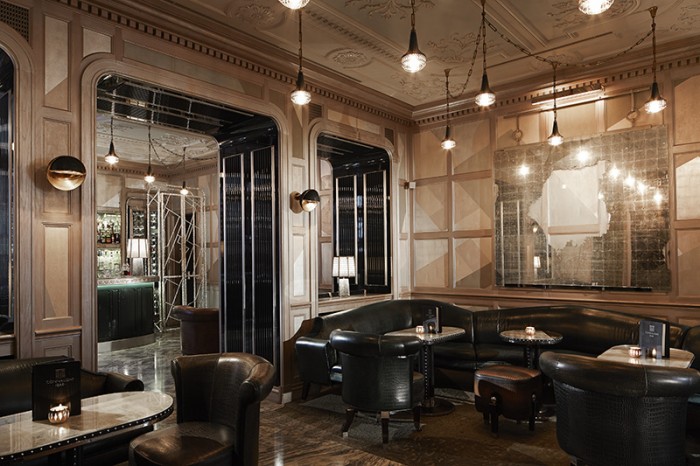
What influence does British Design have internationally (what sets David Collins Studio apart)?
To me, Great Britain is the world leader in creativity and design and, providing we continue to nurture talent, there is no reason why this should not still stand in years to come. On a global scale, the GREAT Campaign – an initiative by Number 10 and UKTI – has been a great platform in showcasing British business and in particular British design with their Festival of Creativity. We were a part of the event in Shanghai last year where it brought together leaders from a wide array of industries with both innovation and design at their core, propelling our talent as whole on the global stage.
We at David Collins Studio, have the ability to bring a European touch of personality, wit and charm, and combine these with historical reference points which result in warm, usable, comfortable, luxurious and timeless interiors. We are unique in the way we approach each design, and no two design processes are the same. I make it my business to understand the culture, the market, the skills, the crafts of each location in which we work to ensure we embrace this and utilise it to its maximum effect. I believe that investing this time upfront makes for a stronger final vision and also creates a design with a truly iconic personality.
“I make it my business to understand the culture, the market, the skills, the crafts of each location in which we work to ensure we embrace this and utilise it to its maximum effect.”
In interior design, and in particular within hospitality, understanding the use of the space is number one. Operations are key and so each project starts with an operational plan and then you get into the more creative elements with layering, details, materials, fittings and lighting. This said, everything needs to work holistically and so having that understanding of the use of the space, the flow of the room, its location and the food are a necessity for the project to be a commercial success. The art is making it appear effortless.
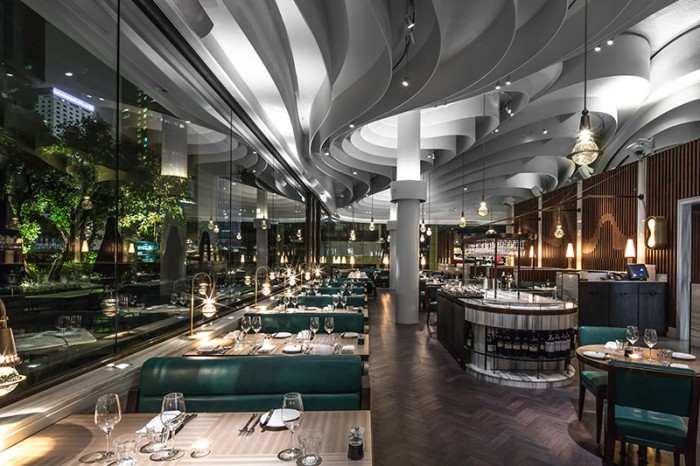
You have created some of the most iconic interiors around the world – what is your approach in creating the perfect ambience?
The approach is different with each project. There is no formula: instinct, feeling, luck, experience all come into play but most importantly you need to have a clear vision and a great team. Inspiration for me comes from a wide variety of elements – growing up in Wales, I was inspired creatively by my father who introduced me to the industry at a young age. The biggest creative inspiration for me throughout my professional career has been David Collins, and the creative teams which surround me on a daily basis.
I am hugely inspired by everything I see on my travels which of course form a large part of what I do as my role at The Studio which takes me currently to Budapest, Melbourne, Hong Kong, Hua Hin and New York to name a few. It is so important that I spend time to culturally immerse myself in a particular country, region or city at the beginning of each project. The food, the social scene, the history and the arts all need to be experienced to deliver a memorable and innovative design. My aspirations lie within the next place I have to discover and I am currently fascinated by the culinary delights, crafts and culture of South East Asia.
All of these inspirations of course form a part of creating the ambience for each of our projects. Although every project is different, you have to immerse yourself into the location and the ambience has to be matched to the architecture and the city in which it stands. Ambience is made up of so many different factors – lighting, the food on offer, the layout of the interior, materials, layering, details – and an interior relies heavily on who is using the space. If a room’s perfect ambience is reached whilst empty, then it’s likely only to improve when being enjoyed.
Do you feel there should be connection between the bar and the rest of the hotel?
A hotel bar has to be many things to many people – perhaps somewhere for a business meeting, a catch up with a friend, a relaxing space as part of your hotel stay, an escape. I like hotel bars to retain their own personality as it makes for a more special experience within a hotel.
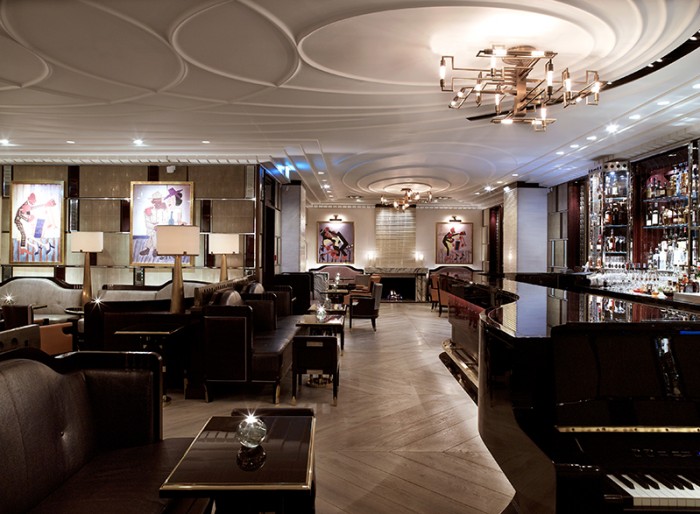
We have been lucky to work with a number of hotel brands on their bar offerings and across each of them, we have kept their own sense of identity – for example the Bassoon Bar at the Corinthia Hotel in London explores the parallels between music and design, at once contemporary and elegant, it also features a 20 foot grand-piano bar. At the iconic The Blue Bar at The Berkeley Hotel, we created a custom colour of blue for the lacquered panelling which comes from the fifty shades of blue that are to be found within the bar, enveloping the room and creating an aura of modernism. The Artesian at The Langham takes its eclectic inspiration from the Victorian cabinets of curiosities and features jewelled panelling, blue and purple crocodile leather , bespoke lacquers referencing La Chasse Aux Papillons and a pagoda bar.
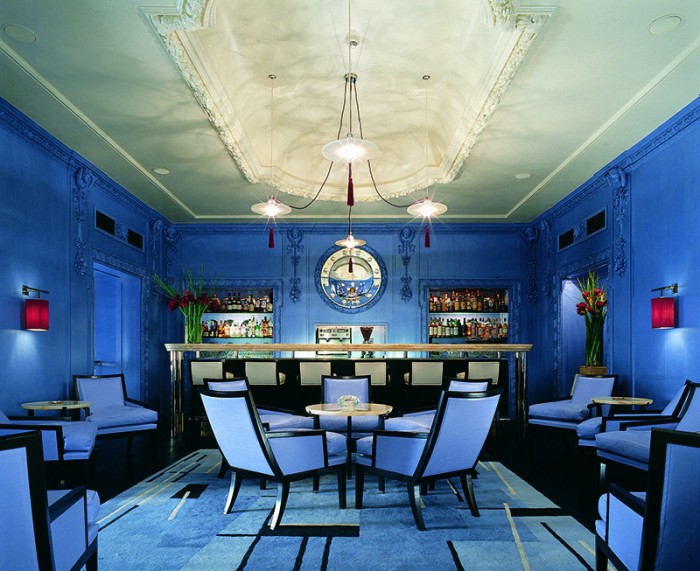
Bars should set a scene, create a fantasy, offer a feeling of glamour, relaxation, occasion, and since our first hotel bar at Claridges – which I have to say looks as beautiful today as it did when we created it almost 20 years ago – it went on to reignite the hotel industry in London and set a new benchmark of luxury standards. It is very flattering to have inspired so many others, but the key is always be different, never repeat yourself, and always stay creative.
How do you see luxury hospitality sector developing – does this vary around the world?
Luxury hospitality is changing. Huge numbers of luxury hotels are coming to market, which are falling in quality. This is leaving room for new independent operators to take on some of the more traditional hotels. No longer do hotels require complex booking networks as guests can easily search and decide from a vast selection of options.
“Luxury hospitality is changing.”
We are currently working on a completely new luxury hotel offer, which I feel the market is ready for. It breaks the rules of the traditional hotel and pushes service discreetly to maximise the needs of today’s luxury traveller through tailored, charming and new ways. I can’t give much more away at this stage, just, watch this space!
Globally, standards are raising and becoming slightly normalised, the ‘international luxury’ look and the ‘mismatched luxury’ are the two main ideas I see on my travels, which is great as more competition makes for better product, however individuality still needs to shine through, such as in The Upper House in Hong Kong. The luxury hospitality sector is one which should not just mean the most expensive, the most lavish, the most detailed – but the one which is most competent at delivering a very high standard across the board.
In interior design, and in particular within hospitality, understanding the use of the space is number one. Simon Rawlings explores ‘The Anatomy of a Restaurant’ in this video with Rowley Leigh Chef & Restauranteur, and Brian Williams Managing Director of Swire Hotels.





